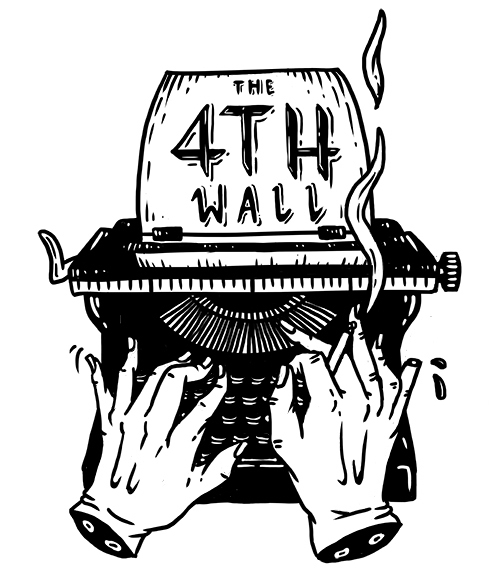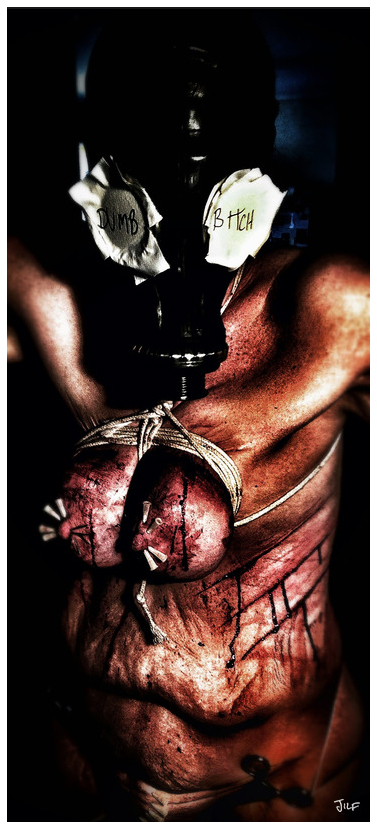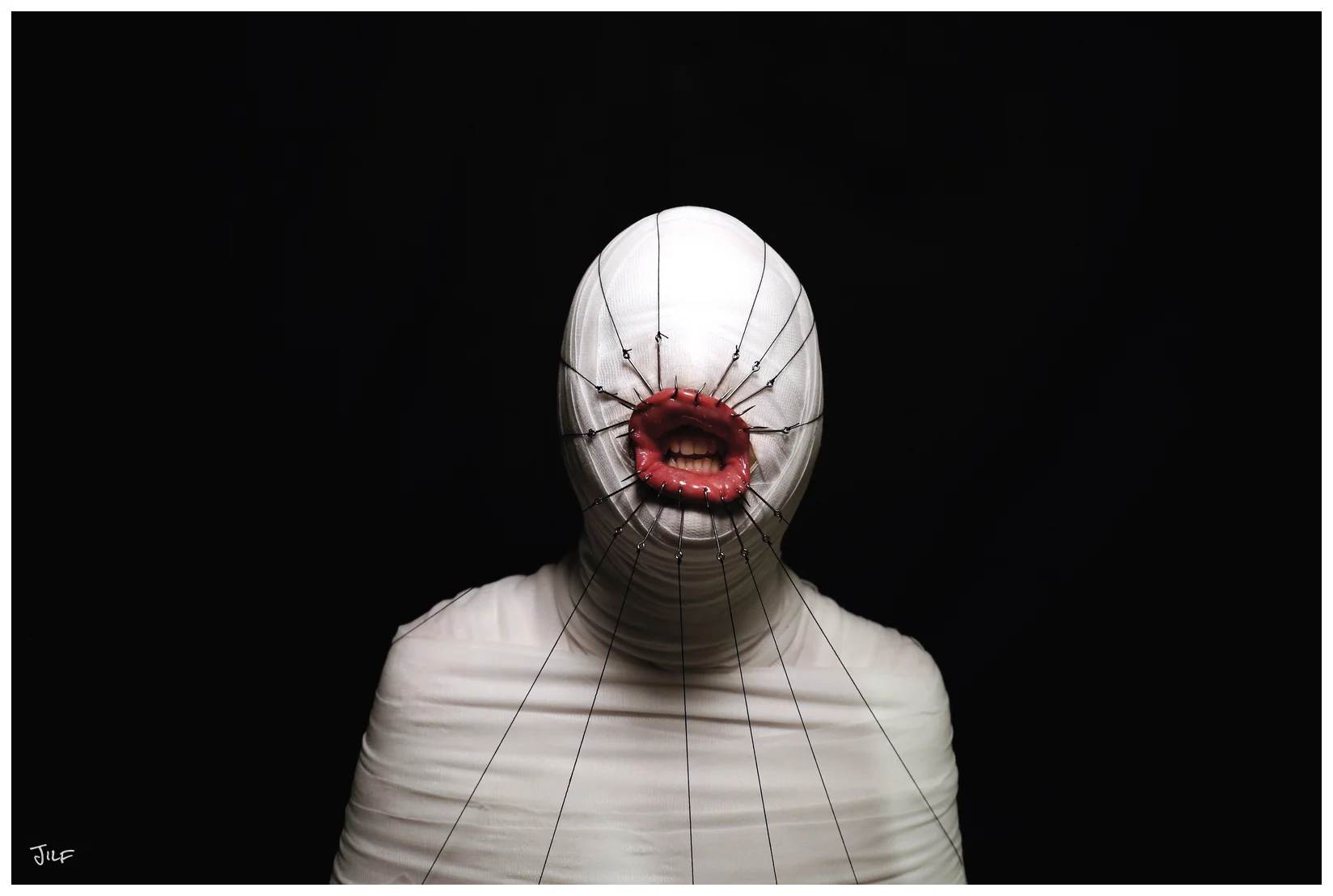(NSFW / TW) “Today, I will suffer for your art”: meet the nihilist going beyond the intersection of kink and body modification to produce traumatic works of art
(Abridged version originally published in VICE 19/03/2018)
As a result of this article VICE AU produced a documentary on JILF for their Violent Times series. I was employed and credited as producer.
“It’s really weird to be so feared in the kink community.”
Jilf, as she is known on Fetlife—an online community for kink, fetish, and BDSM enthusiasts—orchestrates acts of bodily transgression extreme enough to deviate the most deviant of moral compasses. With the aim of eliciting trauma and embracing filth, her partners regularly refrain—“today, I will suffer for your art.”
The Melbourne based nihilist, dominatrix, psychology science graduate, “filthy queer, feminist killjoy, gender-fucker, and bloody sadomasochist pervert,” photographs her hardcore pain rituals and subversive acts to upload to her website and Fetlife. She aims to demonstrate how the ‘disgusting’, as logically connected to beauty through opposition, is also intertwined with morality—or innate lack thereof.
Because what disgusts us in art disgusts us in real-life, the work aims to create sensations in both subject and audience that most of us strive against daily. As JILF describes, “she’ll be covered in filth, her mouth full of tampons and blood, she’s covered in shit and her heads all wrapped up; she’s crying, and she’s distraught, and everything’s so disgusting—everything’s just out. That blows my brain.”
It’s the kind of imagery that has seen her work taken down from almost every online platform. Not only does it go against normative ideas of femininity—“I liken it to a giant ‘fuck you’ to the quiet, subservient female and the historic subjugation of women”—it also challenges the mettle of onlookers, encouraging one to engage in discourse about topics usually avoided. It forces a recalibration of ideas around pain and disgust, and encourages an interrogation of the ways in which our social world has shaped them both.
Beginning from the age of twelve, JILF’s positive relationship with pain and disgust have since revealed their respective capacities to enhance, transform, and enrich an understanding of self and society, and especially pain: “I view pain as a separate entity in any space, it is something to be nurtured and respected, almost deified.”
After seeing her photos shared across the world divorced from their context—“people post it saying ‘this is pretty’, no, somebody was traumatised for that, somebody suffered”—Jilf decided to share her philosophies of embracing trauma and subversion and offer a contextualisation of her most recent project: peeling her partner’s shin. Our discussion reveals that behind each psychologically macabre and surreal photo is a complex process of research, consent, intimacy, pain, and psychological pioneering.
Tell me about your first experimentations with pain.
From twelve years-old I started playing around with pain and blood. I liked the feeling of extracting something that was supposed to be concealed within the body. It was interesting to watch the blood run down my body—I found it fascinating. It seemed like a very intimate process for me and me only, waves of peace would enter my brain. I liked the pain, I liked the blood. I had no idea what it was called back then, but it was not self-harm. In fact, it was totally the opposite—I felt such a deep connection and love with my brain and physical body. I would appreciate what my mind could do—what my body could do.
The exploration was a ritualised embodied experience. I have this same relationship with tattooing, body modification, and Sm—they’re all interconnected.
How did that evolve into the way you engage with pain now?
It grew into a deep love and respect of where pain could take me; both in my body and my mind. I decided to seek it out. I wanted to see if there was anybody else like me out there. I wanted to share that intimacy.
To engage in this level of trust with another person leaves absolutely no room to hide from yourself or them, whether during negotiations and planning or the actual act of sadomasochism itself. When we “play”—for want of a better word—there is no escape from being in that moment. You cannot possibly be anywhere else but with that person sharing a mutual love and respect for the entity that is pain. It evokes visceral feelings of connection and engagement to self and your partners.
What does pain mean, and feel, to you?
Pain, for me, is complex and complicated. It is incredibly nuanced. I view pain as a separate entity in any space. It is something to be nurtured and respected, almost deified. Pain is a way of pushing myself, of finding self. When you engage in hard Sm it’s that feeling of knowing what you’re capable of both physically and emotionally. It is looking at my mind and body and knowing it is strong and capable, knowing that we consented.
Pain is running a gauntlet of body and mind. There is fierceness in it. It is a way of being present, it can also relieve that crushing feeling of existentialism. It can provide recalibration—it is a cathartic release. This is a way of feeling purpose and knowing that I can act on my agency, of having feelings that are not about paying the bills or going to work—the mundanity of everyday existence. Aftercare also brings a ritualized quietness in the body and mind.
What do you label your work as?
“I liken it to a giant “fuck you” to the quiet, subservient female and the historic subjugation of women. ”
My Sm intersects with identity, sexuality, and gender—this is a way of documenting all those intersections. My long-term partners and I do this together—we are quite the well-oiled machine. We do not document everything we do; sometimes it can be a spur of the moment thing during Sm or it can be Sm done to document feminist queer sexuality and BDSM.
Can you tell me a bit about the fish hooked mouth image?
This was one of the times I planned and executed for public voyeurism. I like to fuck with mouths—it’s so very invasive and intrusive. The mouth is also hyper sexual, especially a woman’s. I was looking at my partner’s mouth and I wondered what it would look like if I was to force the mouth open but then subvert the sexualisation of female mouths. I liked the aspect of an open mouth and only an open mouth—a woman’s mouth always open, in this case, forced open.
How do your gender politics permeate and inform your work?
My Sm, from whatever process I am engaging, is my way of subverting dominant paradigms and radically distorting belief systems. It is a way of taking up and commanding space. Of also creating that space. Of forced gaze that is not rooted in the male gaze. Of autonomy and agency. Even putting this work out forces myself and my partners to employ introspection about what is feminism.
It is a way of extracting those flawed dominant discourses and turning them on themselves.
I find it confronting and empowering that women are actively engaging in subversive and transgressive acts. The work goes against feminine societal norms. It is a display of queer female sexuality. I liken it to a giant “fuck you” to the quiet, subservient female and the historic subjugation of women. We embrace our wants and needs by actively and consensually participating in these perverse acts. We play with power structures within our relationships on our terms, and not what society dictates. We get to say, and be, an active participant in these conversations.
And nihilism, how does that inform your work?
Life is absurd and there is no intrinsic meaning, so it means finding and creating meaning in the absurdness. I want to build a subjective creation of meaning. This might mean taking what some would perceive as risks. As a society, we are so conformist—my nihilism leaves room to let go of that conformity. When I sense my physical and mental scars and experiences from Sm I see a life lived. The scars and experiences shared with my partners and by myself are a trajectory or road map of a life lived.
Speaking of nonconformity, you practice an extreme form of BDSM, and the kind of bodily trauma and torture are quite creative and make for some stunning and unique imagery, such as the fish hook piece. What are some things you enjoy doing to the human body, and what has been the most extreme?
“I crave Sm that stretches and challenges my brain. The creating of consensual trauma and violence. ”
I like contorting the female body—making it grotesque. I like being confronted and uncomfortable. I want to evoke visceral emotions, both in myself and my partners. I like playing around in filth. I like blood. I like intrusive acts. Both body and mind. I like heavy CT (cunt torture). Doing 4g labia hooks was an amazing shared experience. Breast skewering. Suspensions. We did 4700 needles in my partner once. I crave Sm that stretches and challenges my brain. The creating of consensual trauma and violence. Things that require unpacking and introspection. It is dependent on where I want to go when I “play”: do I want to disappear with my partner and sit quietly and do “nice” sharps? Or do we want to traverse dark visceral spaces together that are not documented for the public.
The apex of my Sm, though, would be peeling my partner, K. That blew my mind.
Talk me through the process of peeling her, from inception to recovery.
It has been nearly three months since “the peeling”. The whole physical and psychological process from inception to recovery has been incredibly rewarding and absolutely exhausting. It stretched both my partner and I in ways I could never have imagined. The trust we placed in one another is unparalleled. It has deepened our relationship.
The peeled skin
This was a process that was put on the table about 18 months ago. Both the people involved, K and myself, did extensive negotiations. Informed consent and risk mitigation are paramount. Motivation is of utmost importance, which can sometimes be as simple as “why?”—because we can. Most of the time it is quite ritualised so the process can be arduous. This was one of those times. I enjoyed the cognitive and emotional stretch.
“Strangely enough, I could not find any info on how to peel a human.”
Technically, we spoke to a very opened minded doctor regarding physical recovery and body trauma. We planned both physical and emotional recovery in advance. Finding stainless grade tools proved difficult. We ended up finding a specific peeler from overseas. Strangely enough, I could not find any info on how to peel a human.
Research involved looking at skin grafting techniques, etc. We researched anatomy, adding to our prior knowledge. My partner and I researched together and would discuss the risks, which in itself was an intimate process. We did the actual peeling in front of our close Sm family. The set-up—watching everybody get into their individual headspaces, putting all the tools in place, creating a space, prepping the skin (this was done along the shin)—are all rituals we have performed many times both personally and collectively. The anticipation was palpable.
We started off creating a flap of skin that could be inserted into the peeler while leaving enough of the skin flap exposed to be held taught. A friend held the flap, then I basically peeled a layer of skin back up the shin towards the knee. We cooked it, and then we ate a little bit of it. I think it’s one of the most intimate things I’ve ever shared with a human.
Dinner time.
The realness of knowing that I was going to heavily scar a woman—how do you put into words—what it felt like to sit with your “chosen” family and share such a brain blowing intimate moment? All while inflicting excruciating pain and consensual trauma on somebody that you love. Trauma that is not only consented to but welcomed. The next day sitting in the space was emotionally overwhelming. I think even now, nearly three months down the track, it is still raw. It has been complex to unpack.
How do people usually react to your work?
Fear, disgust, confusion, horror, and intrigue. Some have said that it made me their brain “tingle”. Others have felt turned on by the work. I try not to interpret how people feel about my work—whatever you feel is how you feel—I prefer to let people make their own personal interpretations. But a lot of people have thought it beautiful and empowering, most being women, which I have found very interesting.
Sharing your love of consensual pain on a public platform is not for the faint of heart. You must create a barrier at times against vitriolic comments. To display our work leaves nothing to hide behind. Our desires are there in stark black and white or technicolour to be devoured and consumed by the public. It is a display of intimacy, sexuality; perversions. I also see it as an act of defiance. It appears that all we do as a society is avoid and avoid: we do not like discomfort, we avoid pain, we seem to want everything so clear cut and clean. We want humans tidy in their skin-bags.
When I look at art, in whatever form it takes, I want to walk away feeling like my brain, chest, and stomach have been ripped out and absolutely trampled. I like the feeling of wanting to escape and having to sit there uncomfortably, almost like needing to have invisible bondage that forces me to engage in the work. I want to think and unpack it years later. People are writing saying, “you triggered me!”. Personally, I want to be triggered, people don’t want to feel it, they’re like “that was disgusting, we could see inside her body.” All I can say is, “you are disgusting inside!”
I don’t know whether I necessarily want people to be triggered though, rather, I want them to think. To challenge themselves and ask why they feel a certain way. To ask themselves, where is the subversion?
What does engaging with disgust mean to you?
“I find playing in the pool of disgust to be incredibly exposing. It is consensual emotional trauma. It rips my brain out of my skull. ”
I find playing in the pool of disgust to be incredibly exposing. It is consensual emotional trauma. It rips my brain out of my skull. I want to feel that rip. I want to feel the intimacy of mutual exposure and desire. To extract and feel something that evokes disgust that is usually avoided at all costs. It’s interesting that we always want to have these aesthetically appealing facades when we are literally full of blood, piss, and shit. I also like that subversive feeling when out with my female partner, knowing what we do and share in the darkness of disgust. It can feel like the performative nature of a public versus private persona.
Not all Sm is about aesthetics, which is subjective anyway. It is more about the experience, the quiet times after engaging in trauma and especially disgust, the days or sometimes weeks and months spent in mutual intimate reflection. You are enveloped in this shared time of introspection.
Why do you think it’s important to engage with disgust and trauma?
Engaging with discomfort, trauma, and other emotions that are for some reason seen as inherently “bad”, can be a powerful individual or shared experience that leads to various positive outcomes like personal growth, a better understanding of self and those around us. On a personal level, engaging with disgust and trauma is important as it allows me to push my boundaries and examine my own discomfort and emotions. I like to feel confronted or challenged. That, in many cases, is a transformative experience. I believe that a lot of people have an innate curiosity but it is masked by what society dictates to be acceptable or proper.
What would you say to people who interpret your work as pathological and perverse?
Pathological would suggest lack of thought process and consent; no active engagement and desire on both sides; a lack of intention. Conflating consensual Sm with pathology is the easy way out. It would suggest that there is some negative or detrimental underlying reason for what we do. To observe what I do at a deeper level and to sit with the thought that somebody has actively sought hard Sm out can be deeply challenging.













